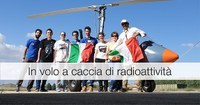 Radioactivity hunt
Radioactivity hunt
If we wake up tomorrow with the news that a serious nuclear accident has happened in Europe, we would ask ourselves: are we able to activate an aerial monitoring of the radioactive fallout of our territory? Is there a European coordination between different teams equipped for these surveys?
Precisely to be prepared for these scenarios, for more than ten years exercises have been periodically organized involving groups equipped with instruments for monitoring radioactivity using aircraft, coming from various European countries. These are the "International Intercomparison Exercises of Airborne Gamma-Spectrometric Systems", which this year took place in Orange in France from 14 to 18 October.
For the first time, an Italian group is taking part, made up of young researchers from the Department of Physics and Earth Sciences of the University of Ferrara and the National Institute of Nuclear Physics (INFN), together with two French teams, one from Germany and one from Czech Republic.
The crews competed in five drills using different helicopters and gamma spectrometers in a kind of radioactivity hunt. Flights were carried out for the real-time identification of radioactive sources located for the occasion in unknown positions and for the characterization of areas of interest from the fallout of radioactive cesium from Chernobyl in the French Maritime Alps. At the end of each day, the groups shared and compared the collected data.
Thanks to the experience gained in the ITALRAD project (ITALian RADioactivity Project) of INFN, funded by the Ministry of University and Research and coordinated by Prof. Fabio Mantovani of the Department of Physics and Earth Sciences of Unife, the Italian group presented itself with an innovative aircraft capable of carrying out radioactivity measurements, but also capable of carrying out photogrammetric surveys with ground resolution of the order of one centimeter.
It is a fully automated instrumentation, which does not require personnel on board the aircraft. All the flight phases were followed in real time by the ground crew, able to check the telemetry, the operation of the instruments and see the footage of the overflown areas.
"We are particularly proud of the technological innovations with which the Italian team presents itself to these European exercises - says Prof. Mantovani - We have tried to simplify, miniaturize and automate each system by focusing on agility, lightness and remote control. Just think that the aircraft We use only 25 liters of fuel per hour compared to 700 for the MI-17 helicopter of the Czech Republic team. Furthermore, ours is the only one that transmits data and images in real time to the ground station. our team this experience is a fundamental test bench to verify the reliability of the instrumentation and to compare ourselves with teams much more experienced than us. "
Thanks to a fruitful synergy between INFN, the University of Ferrara and numerous private companies, the Italian team has been able to enhance the know-how gained in basic research on neutrinos, opening the doors to numerous applications ranging from homeland security to agriculture precision, with technological implications that are part of the Industry 4.0 framework.




